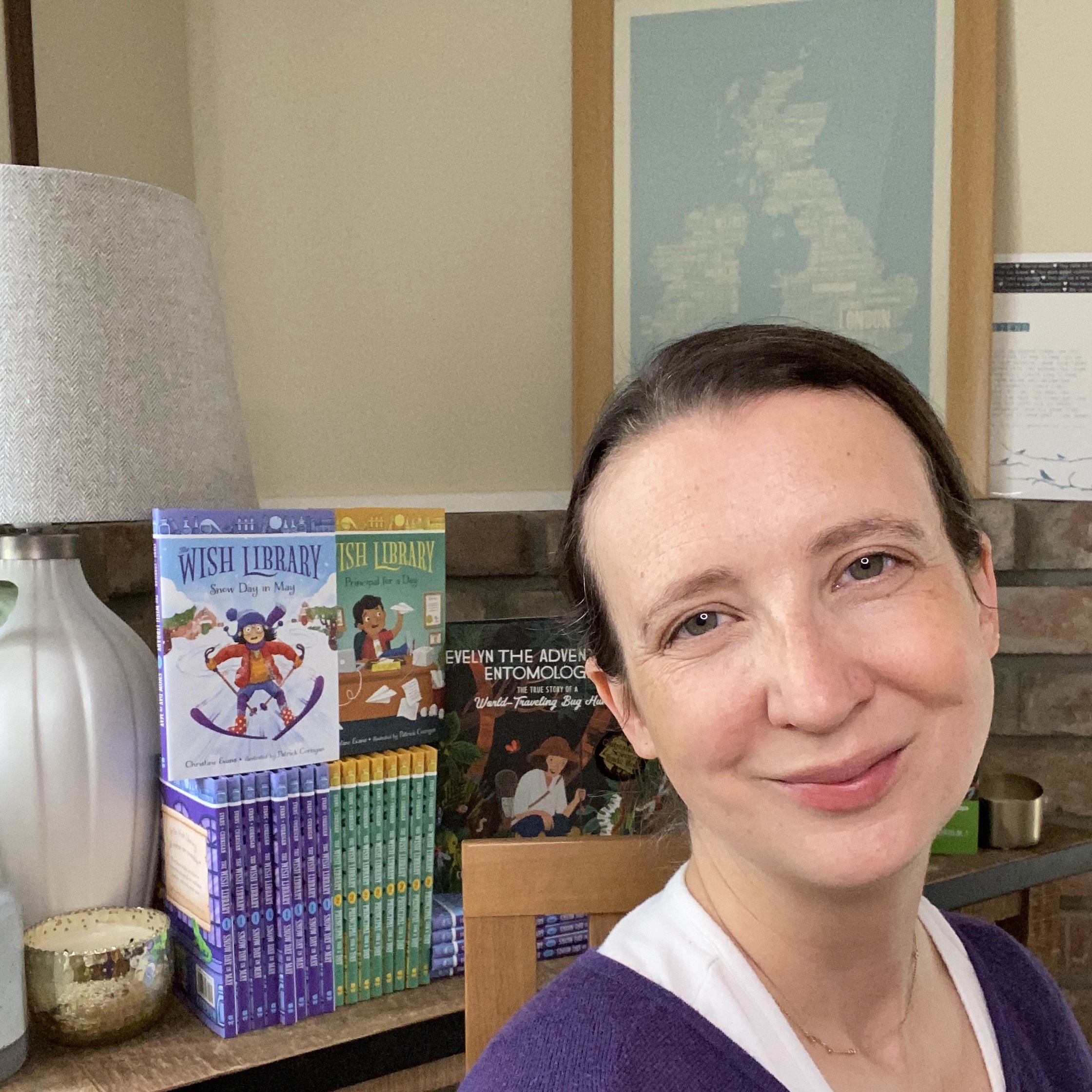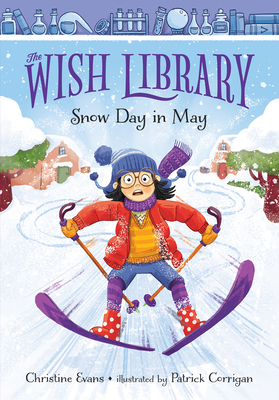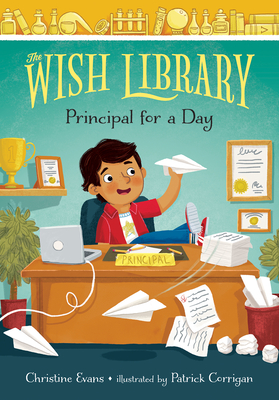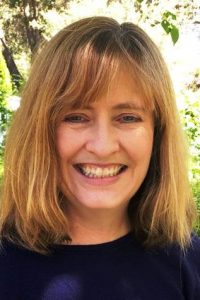I met Christine Evans when she first attended our SCBWI annual regional conference, back when she was just learning the craft of writing for children. At the time, I was part of the regional team and now Christine Evans is the co Regional Advisor running that yearly event. I was delighted by her warm personality and her ready wit and suspected the kidlit community was in for a treat. It’s been a true pleasure to see her writing dreams turn into reality and take flight. Christine’s stories are as charming as she is and filled with heart, adventure and whimsy. In 2019, her debut non-fiction picture book came out–Evelyn the Adventurous Entomologist. In 2020, her debut fiction picture book came out–Emily’s Idea. And now, in 2021, the first two installments of her debut chapter book series–The Wish Library–are already out and another is coming in September! We all can learn a lot from her KidLit journey. –Kristi
KidLit Craft: What do you love about writing for kids?
I love the magic of creating characters, worlds, and stories from a small idea. It’s probably the same reason I enjoy crafting. You start with some raw materials and turn them into something that didn’t exist before. In writing, our raw materials are our ideas and words. And in the end, you have a manuscript (and hopefully eventually, a book) that didn’t exist before.
I especially love writing for kids. Kids need to see themselves and their challenges reflected in books. And they need windows into how other kids live and feel. They learn empathy in the pages of books. And they realize they’re not the only ones to feel that way. Plus sometimes kids need escapism, to run away to magical worlds (magical libraries, or worlds through a wardrobe, or down a rabbit hole) to forget about the real world for a time. It’s a privilege to be able to provide that for kids.
KLC: You’ve written a number of different types of children’s books–nonfiction picture books, fiction picture books, a chapter book series. How do you decide on your next project? And what do you like about the different categories?
I tell kids in my author visits that I choose the stories (fiction or nonfiction) that give me a fluttery feeling. It’s been true of all my projects so far. When an idea takes hold, you can’t shake it off, and you just have to learn more, then that’s the idea to follow.
I love all the categories I’ve written in. My picture book biography was one of those fluttery-feeling projects that I just had to keep following the research on. I loved crafting a narrative out of Evelyn Cheesman’s life story.
I also enjoy the creativity of creating whole worlds, more complex characters and a magic system with my chapter book series. Especially as I get to revisit them over the course of a series (four books so far, or at least it will be once I finish writing the fourth one!)
KLC: Your debut picture book was nonfiction. Was that your first project or had you been experimenting with all the different categories from the beginning? What drew you to that project? Do you anticipate more nonfiction biographies in your future?
My first manuscripts that will forever sit in a dusty virtual drawer were fiction. It wasn’t until I started reading a lot of wonderful biographies that I decided I wanted to write one of my own. I knew I wanted to write about a woman scientist that people hadn’t heard of so when I found Evelyn Cheesman it was an exciting moment! I would love to write more biographies, I just need to find the right person that grabs me like Evelyn did.
KLC: In Evelyn the Adventurous Entomologist, you developed an amazing refrain. How did you go about creating that refrain?
I’ll let you into a secret: the refrain didn’t exist in the version of the manuscript I sold. In fact, the story changed a lot in the editing process.
Once I had a handle on the narrative thread that was driving the story – Evelyn’s perseverance even when people said no – the line, “But Evelyn went anyway”, emerged.
I then looked for opportunities to include that line elsewhere in the story. I identified other times she did something that people thought she couldn’t (go on bug hunts, run an insect house, travel solo, scale a cliff!) and reworked the text so I could include the refrain. Finally I tweaked it for the final line of the book, “Then she spun her stories into books inspiring others to be like Evelyn… And go anyway.”
KLC: Developing characters in such a small number of words is a huge challenge. How do you tackle character development? Does it differ between picture books and chapter books?
The questions I ask when I write are: has the character changed from the start of the book to the end? Have they accomplished their goal (and if not, why not)? And have they gotten what they needed?
In chapter books you have a lot more room and time for character development. That’s not to say I didn’t have to think about it in the picture books. In Evelyn the Adventurous Entomologist I showed how Evelyn went from a bug-loving kid to a world-traveling bug hunter. Even with a true story you have to think about how to show that progression and how they overcame problems (like hanging from a cliff!)
In Snow Day in May, Raven thinks she needs school to be canceled but what she really needs is to find her inner courage and face her fear. So everything in the story is planned to show that progression, from the wish she makes, how she copes when it goes wrong, and how she finds the courage to face what she was trying to avoid.
KLC: Part of working in these categories is the really low word count. Can you talk about how you approach creating fully alive but sparse texts? Do you start with a lot of words and pare down, or do you keep things short from the beginning?
I’m a spare writer – my first draft for Emily’s Idea fitted on my iPhone screen without scrolling!
My editor for the Wish Library series often has to tell me to add more words. I had to learn how to add details like the scene transitions, time of day, interiority, and descriptions. All things I didn’t have to pay as much attention to in picture books (or at least, I didn’t use as many words to describe them.)
KLC: We’d love to hear about your revision process. How do you get from your first draft to the final published version of your stories?
I hate first drafts. I will procrastinate first drafts by writing other ideas and switching between projects. That’s probably a terrible process!
Once I do have that first draft down. I read it aloud (or get my computer to read it) so I can hear places that need attention (stumbling over words, repetition etc). Then I send it to my critique partners for feedback. Sometimes I’ll ask them specific questions but usually I just want to hear their unfiltered thoughts.
Taking the feedback into account, I think about what structural changes are needed to get the story to where I want it to be. As well as considering the character arcs that I already talked about, these are some of the questions I ask:
What is the heart of the story?
What are the themes?
Are there any characters I don’t need? I cut a teacher in Principal for a Day who didn’t have an active role.
Do objects that I later reference appear in earlier scenes? A soccer ball plays an important role in Snow Day in May so I had to make sure Raven packed it in her backpack earlier.
Sometimes I’ll play with different POVs or tenses to see if something else works better. If I want to get closer to my character I find writing it in first person, and then switching it back to third can bring a closer perspective than the first draft.
I play with word choices too. I like to include words relevant to the theme of the story, for example in Evelyn I used insect words like crawled and swarmed to describe people’s actions, so I look for opportunities to add fun words to my WIP.
And then I get more feedback (either from my critique partners, my agent, or in the case of contracted books, my editor) before the next round of revisions. And so on. I revised Evelyn 50 times before publication!
KLC: If you had one piece of advice for other writers of children’s books, what would it be?
My main advice is to keep going. You will get a lot of rejections along the way (and they don’t stop even when you’re agented and published) so you have to learn to separate yourself from the work. They are not rejecting YOU they’re rejecting the work for so many potential reasons. All you can do is to keep creating, keep learning, and move forward. You won’t get published if you give up.
KLC: How has the kidlit community been a part of your writing and publishing journey?
Being a part of the kidlit community has been essential to my journey. I joined SCBWI very early on in my writing career when I didn’t know anything about the publishing process. My first SCBWI event was in 2017 with the wonderful SF/South region at Asilomar in Pacific Grove. There I met my critique partners Vicky Fang and Faith Kazmi and we have been close friends and critique partners ever since. I remember sitting at that conference thinking how fun it would be to be a part of the regional team… four years later and I’m co-regional advisor.
I also joined the 12×12 picture book community in 2017 where I learned (and continue to learn) so much about picture book craft. Being part of a vibrant online community definitely keeps me motivated and inspired to write.
KLC: What can Christine Evans fans look forward to?
More chapter books! Book three in the Wish Library series, Together Forever, will be out in October this year followed by book four in spring 2022. In the meantime I’m playing with several different ideas and formats so stay tuned!

Christine Evans is the author of two picture books, Evelyn the Adventurous Entomologist illustrated by Yas Imamura (Innovation Press, September 2019) and Emily’s Idea illustrated by Marta Álvarez Miguéns (Sounds True, March 2020). Her new chapter book series, The Wish Library, is out now (Albert Whitman).
She is represented by Elizabeth Bennett from Transatlantic Agency. Christine is also the co-Regional Advisor for the San Francisco/South region of SCBWI.
Christine has jumped out of a plane once, windsurfed once, and water skied once. She much prefers books and writing to adrenaline sports. She is a British expat and has lived in California for eight years with her husband, two young daughters, and her tiny Yorkshire terrier.
If you enjoyed hearing about Christine’s KidLit journey, check out these author Q&As too!
Kristi Wright (co-editor) writes picture books and middle grade novels. Her goal as a writer is to give children a sense of wonder, a hopefulness about humanity, and a belief in their future. She is represented by Kurestin Armada at Root Literary. She is an active volunteer for SCBWI and a 12 X 12 member. Find her at www.kristiwrightauthor.com and on Twitter @KristiWrite.






COMMENTs:
0